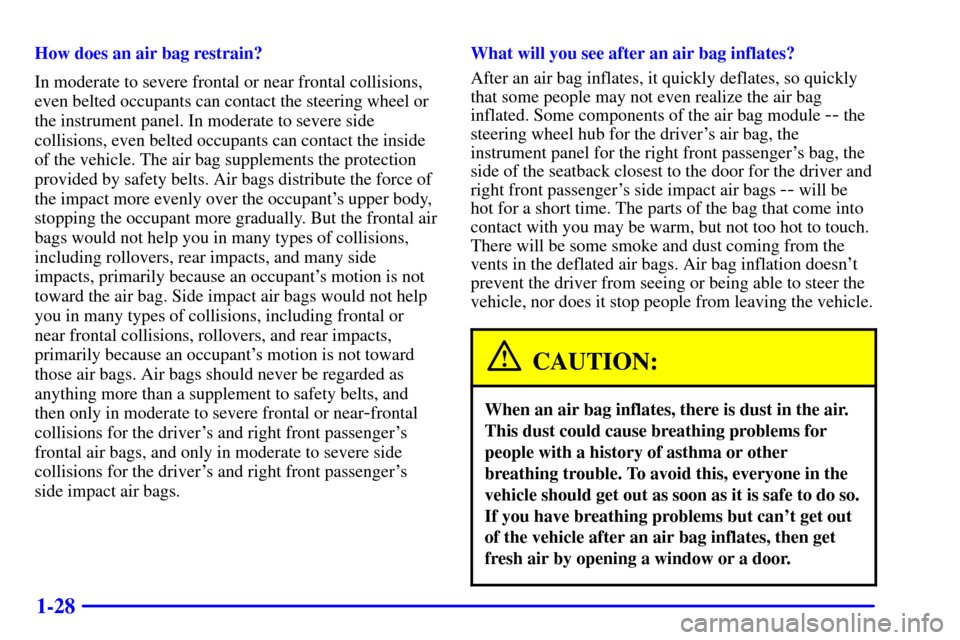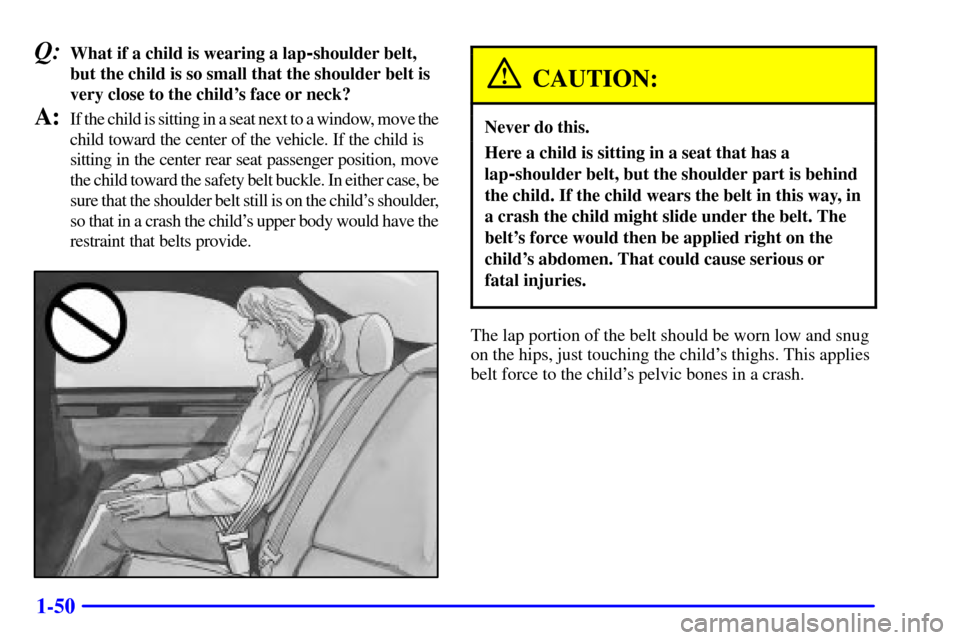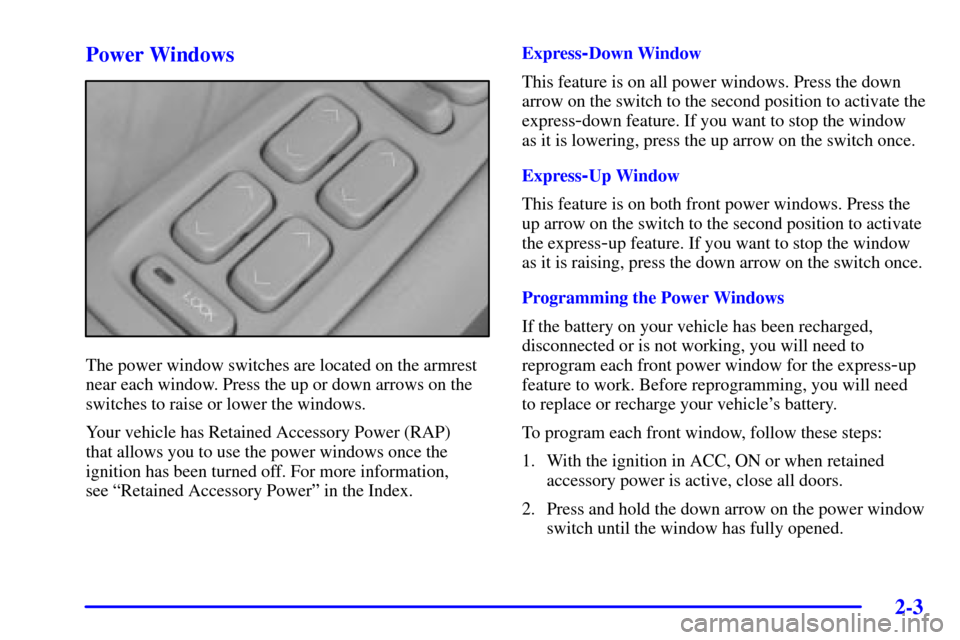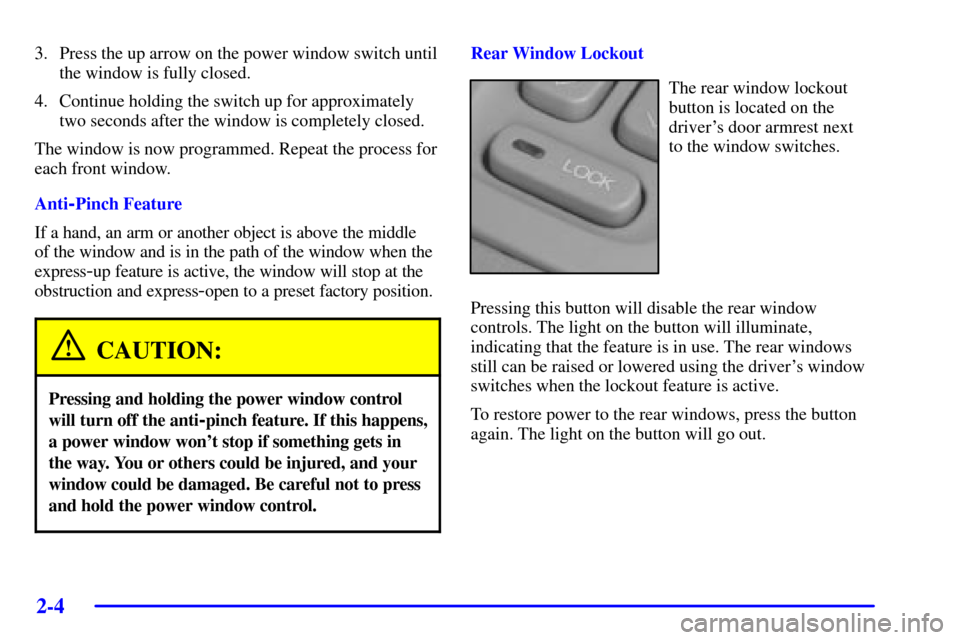Page 34 of 399

1-28
How does an air bag restrain?
In moderate to severe frontal or near frontal collisions,
even belted occupants can contact the steering wheel or
the instrument panel. In moderate to severe side
collisions, even belted occupants can contact the inside
of the vehicle. The air bag supplements the protection
provided by safety belts. Air bags distribute the force of
the impact more evenly over the occupant's upper body,
stopping the occupant more gradually. But the frontal air
bags would not help you in many types of collisions,
including rollovers, rear impacts, and many side
impacts, primarily because an occupant's motion is not
toward the air bag. Side impact air bags would not help
you in many types of collisions, including frontal or
near frontal collisions, rollovers, and rear impacts,
primarily because an occupant's motion is not toward
those air bags. Air bags should never be regarded as
anything more than a supplement to safety belts, and
then only in moderate to severe frontal or near
-frontal
collisions for the driver's and right front passenger's
frontal air bags, and only in moderate to severe side
collisions for the driver's and right front passenger's
side impact air bags.What will you see after an air bag inflates?
After an air bag inflates, it quickly deflates, so quickly
that some people may not even realize the air bag
inflated. Some components of the air bag module
-- the
steering wheel hub for the driver's air bag, the
instrument panel for the right front passenger's bag, the
side of the seatback closest to the door for the driver and
right front passenger's side impact air bags
-- will be
hot for a short time. The parts of the bag that come into
contact with you may be warm, but not too hot to touch.
There will be some smoke and dust coming from the
vents in the deflated air bags. Air bag inflation doesn't
prevent the driver from seeing or being able to steer the
vehicle, nor does it stop people from leaving the vehicle.
CAUTION:
When an air bag inflates, there is dust in the air.
This dust could cause breathing problems for
people with a history of asthma or other
breathing trouble. To avoid this, everyone in the
vehicle should get out as soon as it is safe to do so.
If you have breathing problems but can't get out
of the vehicle after an air bag inflates, then get
fresh air by opening a window or a door.
Page 45 of 399
1-39
A forward-facing child seat (C-E) provides restraint for
the child's body with the harness and also sometimes
with surfaces such as T
-shaped or shelf-like shields.
A booster seat (F-G) is a child restraint designed to
improve the fit of the vehicle's safety belt system. Some
booster seats have a shoulder belt positioner, and some
high
-back booster seats have a five-point harness. A
booster seat can also help a child to see out the window.
Page 56 of 399

1-50
Q:What if a child is wearing a lap-shoulder belt,
but the child is so small that the shoulder belt is
very close to the child's face or neck?
A:If the child is sitting in a seat next to a window, move the
child toward the center of the vehicle. If the child is
sitting in the center rear seat passenger position, move
the child toward the safety belt buckle. In either case, be
sure that the shoulder belt still is on the child's shoulder,
so that in a crash the child's upper body would have the
restraint that belts provide.
CAUTION:
Never do this.
Here a child is sitting in a seat that has a
lap
-shoulder belt, but the shoulder part is behind
the child. If the child wears the belt in this way, in
a crash the child might slide under the belt. The
belt's force would then be applied right on the
child's abdomen. That could cause serious or
fatal injuries.
The lap portion of the belt should be worn low and snug
on the hips, just touching the child's thighs. This applies
belt force to the child's pelvic bones in a crash.
Page 58 of 399

2-
2-1
Section 2 Features and Controls
Here you can learn about the many standard and optional features on your vehicle, and information on starting,
shifting and braking. Also explained are the instrument panel and the warning systems that tell you if everything is
working properly
-- and what to do if you have a problem.
2
-2 Windows
2
-5 Keys
2
-7 Door Locks
2
-10 Remote Keyless Entry System
2
-14 Trunk
2
-17 Theft
2
-18 Theft-Deterrent System
2
-20 PASS-Key� III
2
-22 New Vehicle ªBreak-Inº
2
-22 Ignition Positions
2
-24 Starting Your Engine
2
-25 Engine Coolant Heater (If Equipped)
2
-27 Automatic Transaxle Operation
2
-31 Parking Brake
2
-33 Shifting Into PARK (P)
2
-35 Shifting Out of PARK (P)
2
-35 Parking Over Things That Burn
2
-36 Engine Exhaust2
-36 Running Your Engine While You're Parked
2
-37 Tilt Wheel
2
-39 Turn Signal/Multifunction Lever
2
-46 Exterior Lamps
2
-51 Interior Lamps
2
-53 Mirrors
2
-58 Storage Compartments
2
-59 Sun Visors
2
-66 Sunroof (Option)
2
-67 HomeLink� Transmitter (If Equipped)
2
-70 The Instrument Panel -- Your
Information System
2
-75 Warning Lights, Gages and Indicators
2
-88 Driver Information Center (DIC)
2
-99 Vehicle Programming and
Personalization Features
2
-113 Navigation (Option)
2
-114 Ultrasonic Rear Parking Assist (URPA)
Page 59 of 399
2-2
Windows
CAUTION:
Leaving children in a vehicle with the windows
closed is dangerous. A child can be overcome
by the extreme heat and can suffer permanent
injuries or even death from heat stroke.
Never leave a child alone in a vehicle, especially
with the windows closed in warm or hot weather.
Page 60 of 399

2-3 Power Windows
The power window switches are located on the armrest
near each window. Press the up or down arrows on the
switches to raise or lower the windows.
Your vehicle has Retained Accessory Power (RAP)
that allows you to use the power windows once the
ignition has been turned off. For more information,
see ªRetained Accessory Powerº in the Index.Express
-Down Window
This feature is on all power windows. Press the down
arrow on the switch to the second position to activate the
express
-down feature. If you want to stop the window
as it is lowering, press the up arrow on the switch once.
Express
-Up Window
This feature is on both front power windows. Press the
up arrow on the switch to the second position to activate
the express
-up feature. If you want to stop the window
as it is raising, press the down arrow on the switch once.
Programming the Power Windows
If the battery on your vehicle has been recharged,
disconnected or is not working, you will need to
reprogram each front power window for the express
-up
feature to work. Before reprogramming, you will need
to replace or recharge your vehicle's battery.
To program each front window, follow these steps:
1. With the ignition in ACC, ON or when retained
accessory power is active, close all doors.
2. Press and hold the down arrow on the power window
switch until the window has fully opened.
Page 61 of 399

2-4
3. Press the up arrow on the power window switch until
the window is fully closed.
4. Continue holding the switch up for approximately
two seconds after the window is completely closed.
The window is now programmed. Repeat the process for
each front window.
Anti
-Pinch Feature
If a hand, an arm or another object is above the middle
of the window and is in the path of the window when the
express
-up feature is active, the window will stop at the
obstruction and express
-open to a preset factory position.
CAUTION:
Pressing and holding the power window control
will turn off the anti
-pinch feature. If this happens,
a power window won't stop if something gets in
the way. You or others could be injured, and your
window could be damaged. Be careful not to press
and hold the power window control.
Rear Window Lockout
The rear window lockout
button is located on the
driver's door armrest next
to the window switches.
Pressing this button will disable the rear window
controls. The light on the button will illuminate,
indicating that the feature is in use. The rear windows
still can be raised or lowered using the driver's window
switches when the lockout feature is active.
To restore power to the rear windows, press the button
again. The light on the button will go out.
Page 62 of 399
2-5
Keys
CAUTION:
Leaving children in a vehicle with the ignition
key is dangerous for many reasons. A child or
others could be badly injured or even killed.
They could operate the power windows or other
controls or even make the vehicle move. If they
turned the ignition to ACC or ON and moved the
shift lever out of PARK (P), that would release
the parking brake. Don't leave the keys in a
vehicle with children.